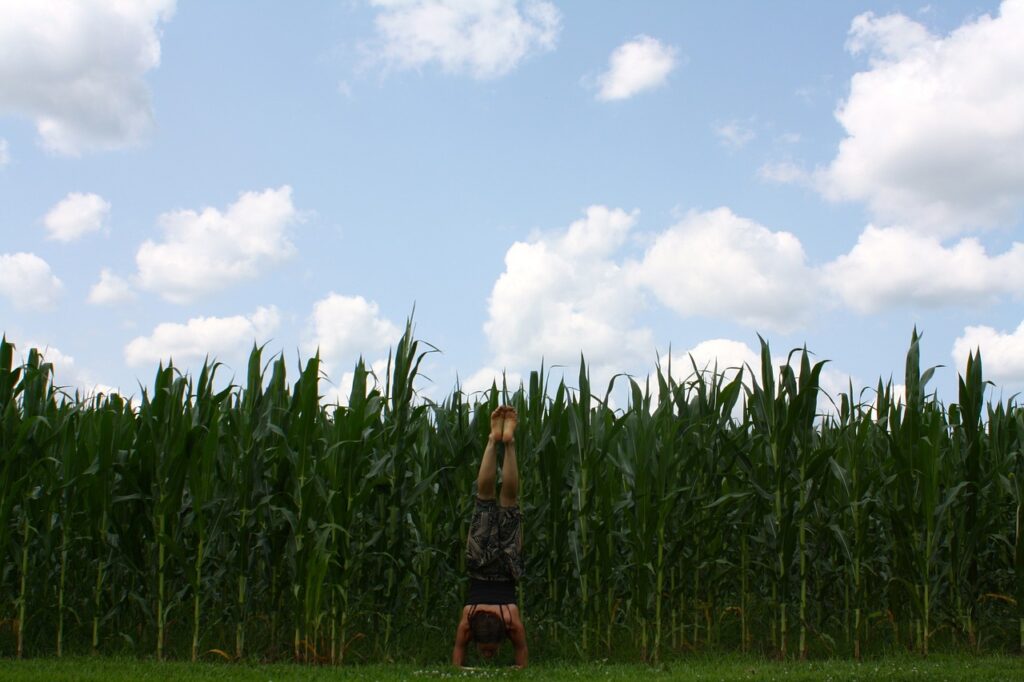Are you eager to master inversions in your yoga practice, but concerned about doing them safely? Whether you’re a beginner or have been practicing yoga for years, inversions can be intimidating. However, with the right techniques and precautions, you can safely incorporate them into your practice. In this article, we will explore various tips and guidelines to help you practice inversions safely, allowing you to reap the many benefits they offer for both your physical and mental well-being. So, let’s dive into the world of inversions and discover how you can confidently and safely explore these transformative poses.
Importance of Safety in Inversions
When it comes to inversions in yoga, safety should always be your top priority. Inversions, such as headstands and handstands, can offer numerous benefits for both the body and mind. However, it is crucial to understand the risks involved and develop a safe and consistent practice to avoid injury.
Understanding the Risks
Inversions, especially those involving balancing your body upside down, can place a significant amount of strain on various muscles and joints. Without proper preparation and execution, these poses can potentially lead to muscle strains, falls, and even more serious injuries. It is essential to be aware of the risks involved in inversions and take the necessary precautions to ensure your safety.
Benefits of Inversions
Despite the risks, practicing inversions can provide numerous benefits. They can help improve circulation, increase strength in the upper body, enhance flexibility, and boost overall body awareness. Inversions also stimulate the nervous system, allowing you to experience a sense of calm and mental clarity. With their array of advantages, inversions can be a valuable addition to your yoga practice, as long as you approach them with caution and respect for your body’s limitations.
Developing a Safe Practice
To practice inversions safely, it is crucial to develop a strong foundation and gradually build up your skills. Incorporating preparatory exercises, choosing suitable inversions for your level, using props for support, maintaining proper alignment, and listening to your body are all key elements in developing a safe practice. By following these guidelines and staying consistent in your practice, you can minimize the risks and fully enjoy the benefits of inversions.
Preparatory Exercises for Inversions
Before attempting inversions, it is essential to engage in preparatory exercises to build the necessary strength, core conditioning, and flexibility. These exercises will help you establish a solid foundation and reduce the risk of injury when performing inversions.
Strengthening the Upper Body
Since inversions heavily rely on upper body strength, it is crucial to engage in exercises that target the arms, shoulders, and upper back. Push-ups, dolphin pose, and plank variations can all help strengthen these areas. By gradually increasing your upper body strength, you will be better equipped to support your body weight during inversions.
Core Conditioning
A strong core is crucial for maintaining balance and stability in inversions. Exercises like boat pose, forearm plank, and bicycle crunches can help strengthen your abdominal muscles and improve your core stability. By focusing on core conditioning, you will enhance your ability to control your body during inversions and reduce the risk of collapsing or toppling over.
Improving Flexibility
Flexibility is another essential aspect to consider when practicing inversions. Stretching exercises for the hamstrings, shoulders, and hips, such as forward folds, shoulder stretches, and hip openers, can help improve your overall flexibility. Adequate flexibility will allow you to find the proper alignment in inversions and minimize strain on your muscles and joints.

Choosing the Right Inversions for Your Level
When starting with inversions, it is crucial to choose poses that match your skill level and gradually progress as you become more comfortable and confident. Beginning with beginner-friendly inversions will help you build the necessary strength and body awareness before moving on to more challenging poses.
Beginner-Friendly Inversions
For beginners, inversions such as supported shoulder stand, legs up the wall pose, and dolphin pose can be excellent starting points. These poses provide the benefits of inversions while offering more support and stability. As you gain strength and confidence, you can gradually introduce more intermediate inversions into your practice.
Intermediate Inversions
Intermediate inversions, such as forearm stand, headstand with a wall support, and supported handstand, require a higher level of strength and balance. These poses challenge your body in new ways, helping you develop further as a practitioner. However, it is crucial to approach these inversions mindfully and only progress once you feel ready and comfortable.
Advanced Inversions
Advanced inversions like headstands, handstands, and scorpion pose require a significant amount of strength, flexibility, and body awareness. These poses often involve more complex alignment and control. It is vital to have a strong foundation and guidance from an experienced instructor before attempting advanced inversions. Practicing these poses without proper preparation can lead to injury.
Using Props for Support
Props can be invaluable tools in maintaining stability and support during inversions. They can help modify poses, prevent injuries, and deepen your practice. Here are some commonly used props for inversion practice:
Blocks
Blocks are versatile props that can be used in various inversions to support and elevate parts of the body. Placing blocks under your hands during headstands or forearm stands can provide extra height and stability, aiding in alignment and reducing strain on the wrists.
Straps
Straps can be helpful when working on shoulder opening and flexibility. In poses like shoulderstand or plow pose, using a strap around the upper arms can prevent the shoulders from collapsing forward and provide a gentle reminder to engage the muscles.
Bolsters
Bolsters, especially when placed against the wall, can offer support and cushioning during inversions. They can be used as a barrier between your head and the floor in headstands, providing a sense of safety and reducing the fear of falling.
Using props while practicing inversions can give you the confidence to explore and progress in a safe and supported manner. It is advisable to consult with a knowledgeable instructor to learn proper prop usage and determine which props are most suitable for your specific needs.

Proper Alignment in Inversions
Maintaining proper alignment is crucial for preventing injuries and maximizing the benefits of inversions. Here are key alignment principles to focus on during inversions:
Engaging the Shoulders
In inversions, it is important to actively engage and stabilize the shoulders. Drawing the shoulder blades down the back and away from the ears will help create space and maintain stability in the shoulder girdle. This engagement will also protect the neck and prevent excessive strain.
Aligning the Hips and Pelvis
Proper alignment of the hips and pelvis is essential for maintaining balance during inversions. The hips should be squared and level, with neither hip dropping or lifting higher than the other. This alignment allows for optimal stability and prevents strain on the lower back.
Keeping a Neutral Spine
Maintaining a neutral spine is crucial for overall alignment and safety in inversions. Avoiding excessive arching or rounding of the back will help protect the spine and prevent unnecessary strain. Engaging the core muscles will aid in maintaining a stable and neutral spine position.
By focusing on proper alignment during inversions, you can ensure that your body is in the optimal position to support and distribute weight evenly. Practicing with the guidance of an experienced instructor can help you refine your alignment and prevent common mistakes.
Developing a Strong Foundation
A strong foundation is key to practicing inversions safely and effectively. Here are some aspects to focus on when building a solid base:
Building Core Strength
A strong core is fundamental for maintaining stability and control during inversions. Regular core-strengthening exercises, such as planks, boat pose variations, and leg raises, will help build the necessary strength to support your body weight.
Working on Balance
Inversions require a high level of balance and body awareness. Incorporating balance exercises into your practice, such as tree pose, eagle pose, and one-legged standing poses, will help improve your proprioception and enhance your ability to find stability both on and off the mat.
Improving Body Awareness
Developing body awareness is essential for understanding your limitations and avoiding overexertion. Practicing mindfulness and focusing on how each movement feels in your body will help you recognize when to push yourself and when to back off. Listening to your body’s signals is crucial for injury prevention and maintaining a safe inversion practice.

Listening to Your Body
One of the most vital aspects of practicing inversions safely is listening to your body and respecting its limitations. Yoga is a journey of self-discovery and self-care, and tuning in to your body’s needs is a crucial part of that journey. Here are some points to consider:
Recognizing Limitations
Everyone’s body is unique, and what may be accessible or comfortable for one person might not be for another. It is essential to listen to your body and honor its limitations. Pushing beyond your limits can lead to injury and hinder your progress. Accept where you are in your practice and work within your own capabilities.
Modifying Poses
Modifying poses is not a sign of weakness but rather a wise choice to adapt the practice to your individual needs. If a particular inversion feels challenging or inaccessible, explore modifications that allow you to experience the benefits without compromising safety. Using props or seeking guidance from an experienced instructor can help you find suitable modifications for your practice.
Taking Rest when Needed
Rest is an integral part of any yoga practice, including inversions. If you feel fatigued or overwhelmed during inversions, it is crucial to listen to your body’s signals and take a break. Stepping back and resting helps prevent burnout and reduces the risk of injury. Incorporating rest days into your practice schedule is equally important for allowing your body to recover and rejuvenate.
Working with an Experienced Instructor
Practicing inversions, especially as a beginner or intermediate student, can greatly benefit from the guidance of an experienced instructor. Seeking the assistance of a qualified teacher can provide personalized feedback, ensure correct alignment, and offer modifications suited to your specific needs. Here are some points to consider when working with an instructor:
Finding a Qualified Teacher
When looking for an instructor to guide you in your inversion practice, it is essential to find someone with the necessary experience, training, and expertise. Take the time to research instructors in your area or online, read reviews, and inquire about their qualifications. Finding a teacher who resonates with you and prioritizes safety will greatly enhance your learning experience.
Taking Group Classes
Group classes offer a supportive and communal atmosphere, allowing you to benefit from collective energy and motivation. In a group setting, you can observe different individuals’ approaches and receive hands-on adjustments from the instructor when needed. However, it is important to communicate any injuries or concerns with the teacher to ensure modifications are provided as necessary.
Private Instruction
For a more personalized approach, private instruction can be highly beneficial, especially for those with specific goals, injuries, or a desire to deepen their inversion practice. Private sessions offer one-on-one guidance and the opportunity to tailor the practice to your individual needs. A private instructor can provide focused attention, address specific concerns, and help you progress at your own pace.
Working with an experienced instructor provides valuable guidance and feedback, ensuring that you are practicing inversions safely and effectively. Their knowledge and expertise can help you overcome obstacles, refine your technique, and advance your practice in a way that supports your overall well-being.
Breathing Techniques and Inversions
Breath awareness is an integral part of any yoga practice, including inversions. Incorporating specific breathing techniques can help you stay grounded, focused, and calm during inversions. Here are some important breathing techniques to consider:
Connecting Breath with Movement
Incorporating breath with movement synchronizes the mind and body, facilitating a sense of flow and ease in inversions. During each inversion, focus on deep and steady breaths, allowing the breath to guide the movement. Cultivating a conscious connection between breath and movement can help you stay centered and present during the practice.
Practicing Ujjayi Breath
Ujjayi breath, also known as victorious breath, involves gentle constriction of the throat during inhalation and exhalation. This audible breath creates a soft, oceanic sound and helps calm the mind while providing a focal point. Practicing Ujjayi breath during inversions can increase breath awareness and aid in maintaining a steady rhythm.
Using Breath to Stay Calm and Focused
Inversions can evoke various emotions and sensations in the body. Focusing on deep, controlled breathing can help you stay calm and focused, regardless of the challenges you may encounter. By directing your attention to the breath, you can cultivate a state of mindfulness and navigate through inversions with greater ease.
The Role of Practice and Consistency
Practicing inversions requires patience, persistence, and consistency. Here are some factors to consider in developing a consistent inversion practice:
Starting Slowly and Progressing
Inversions are a journey that requires gradual progression. Begin with beginner-friendly inversions, focusing on building strength and body awareness. As you feel more comfortable and confident, gradually introduce more intermediate and advanced inversions into your practice. Being mindful of your body’s progression and avoiding rushing will help you establish a safe and sustainable practice.
Regular Practice for Improved Strength
Consistency is key when it comes to developing strength and stability in inversions. Regularly practicing poses that target the upper body, core, and flexibility will help build the necessary strength and stability required for inversions. Aim for a balanced practice that includes both active strengthening exercises and restorative poses to allow for recovery.
Patience and Persistence
Inversions, like any other aspect of yoga, require patience and persistence. Progress may not come as quickly as you would like, but consistency and dedication to your practice will yield results over time. Celebrate every small achievement along the way and embrace the learning process, understanding that each practice is an opportunity for growth and exploration.
By acknowledging the importance of practice and consistency, you can cultivate a safe and fulfilling inversion practice that supports your overall well-being and enjoyment of yoga as a whole.
In conclusion, practicing inversions in yoga can bring numerous benefits to both the body and mind, but safety should always be the top priority. Understanding the risks involved, developing a strong foundation, choosing suitable inversions for your level, using props for support, maintaining proper alignment, listening to your body, working with an experienced instructor, incorporating breathing techniques, and practicing consistently are all essential elements in safely practicing inversions. By following these guidelines and approaching inversions with respect and caution, you can enjoy the transformative power of inversions while minimizing the risks of injury. So, embrace the journey, stay curious, and have fun exploring the world of inversions with safety as your guiding principle. Happy practicing!

